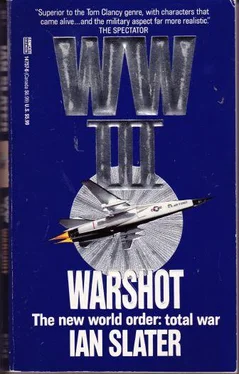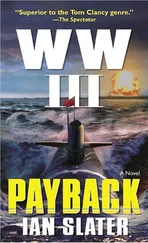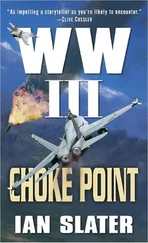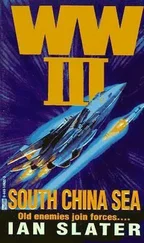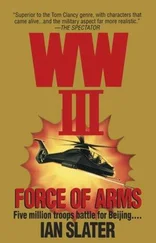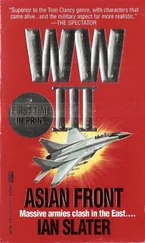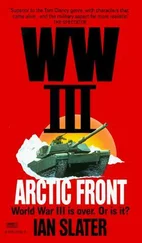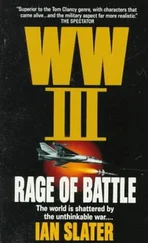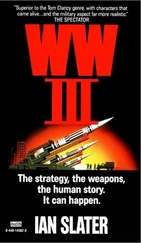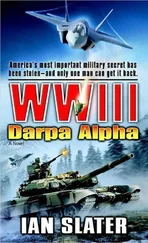Freeman turned his attention to the map of the naval supply line, stretching all the way from America’s west coast through the Kuril Island gaps, immediately north of Japan, through the Sea of Okhotsk to Siberia. It was another possible weak link, for if the Siberian Alfa Hunter/Killer subs could plug the narrow, shallow gaps between the Kurils — the gateway to the Sea of Okhotsk — then the enemy could quite literally turn off the oil supply to Freeman’s entire Second Army, the general reminding Norton of George Patton’s famous dictum: “My men can eat their boots, but my tanks gotta have gas!” Which for just one M1A1 meant two and a half gallons for every mile.
Even as Freeman spoke, the sonar operator aboard the Sea Wolf USS Reagan on war patrol just east of the Kuril Islands heard a faint pulse through the undersea “frying” of shrimps clicking and whales moaning, and alerted the executive officer, Hale, now captain in Robert Brentwood’s absence; Merrick, in turn, had moved up to be the XO. When Hale heard the sonar bong by his bunk, he got up so fast, he knocked over the picture of his wife and two children, and within a minute — still stuffing his shirt inside his trousers — was standing inside the brass rail that skirted the scope island in Reagan’s redded-out combat control center. He wanted coffee, but Robert Brentwood had strictly enforced his no-liquid, no-food rule in the CCC.
“What’ve we got, Sonar?” Hale asked raspily, looking at the three-tiered green screen.
“Unidentified submarine, sir. Suspected hostile by nature of sound.”
“Signature?”
“Negative.” It meant there wasn’t enough noise being emitted by the unidentified craft as yet to get a “prop-print” from the computer library, which could identify a specific vessel by matching its in-transit sound which, like the sound of every human being, had an individual “voice” print. But sometimes the enemy tried to add a baffle, a steel plate welded here or there, or extra acoustic, sound-absorbing tile on the superstructure to alter their noise signature. Even so, a good operator, like leading sonarman Rogers — whose higher-range hearing hadn’t been damaged by too much “hard rock” music when he was younger — could often identify the class of ship from a sound which, to someone else’s hearing, would have been the faintest pulsing of a prop.
“I’d say an Alfa,” said Rogers, adding, “Might have flaked,” indicating that the fast, forty-five-knot Hunter/Killer Alfa might have lost part of its anechoic paint, designed to absorb rather than reflect the ping of a searching sub’s “active” sonar. But Hale had the USS Reagan’s sonar on “passive”—listening mode only, the sub itself on silent running. While its nuclear reactor was unable to be shut down completely, it was heavily muffled, the reactor crew wearing their yellow booties, not only to prevent them from transferring any possible radioactive particles from the “coffeepot” or nuclear reactor throughout the sub, but to prevent even the sound of footsteps radiating through the hull.
“Sir — correction,” said Rogers. “Louder now. It’s a diesel — a quiet one, all right, but a diesel beat for sure. Ten thousand yards — closing!”
“Print out possible hostiles,” ordered Hale, also informing the crew quickly, calmly, “Mr. Merrick retains the deck. I have the con.” They were now well beyond the relatively shallow shelf of the Kuril Gap, into deeper water. Merrick, as XO in Brentwood’s absence, immediately took up his position as officer of the deck behind the two planesmen, noting one whose face was beaded in perspiration. Wordlessly, he pulled out a damp tissue from the flip-up box and, so as not to alarm the planesman or divert his attention, he simply said, “Wiping,” and drew the tissue across the man’s forehead. A millisecond lost because of stinging perspiration in the eyes could put them all dead in the path of a torpedo or SUBROC. Sonar’s auxiliary screen was now a column of brown X’s, signifying the different classes of diesel to the right of each, listing speed — surfaced and dived — displacement, missiles, radar arrays, sonars, and officer/crew complement.
“Your best estimate?” Hale asked Rogers. They had worked together on the nuclear submarine Roosevelt, which, after sinking an enemy sub and sustaining considerable damage herself, had to be scuttled in the Arctic lest her vital coding machines be captured.
“Present speed, submerged,” said Rogers, his tone controlled and assured. “Plus or minus twenty-five knots. Displacement… plus or minus two point five. I’d say Soviet Kilo class. Three thousand eight hundred yards and closing. Bearing zero-three-niner.”
“Man battle stations!” ordered Hale, the chime alert bonging softly throughout the submarine. “Speed?”
“Twenty knots,” answered Rogers.
“Hard left rudder to one-three-five degrees,” ordered Hale.
“Left rudder to one-three-five degrees,” confirmed Rogers, the diving officer watching rudder and trim control.
“Bearing?” asked Hale.
“Zero-three-niner,” came the response.
“Mark! Range?”
“Four thousand.”
“Angle on the bow,” said Hale, beginning the litany of his attack. “Starboard one-four. Firing point procedures. Master one-zero. Tube one.”
“Firing point procedures. Master one-zero. Tube one,” came the confirmation. “Solution ready, sir. Weapons ready. Ship ready.”
“Final bearing and shoot,” announced Hale. “Master one-zero. Tube one.”
Bearing and speed confirmed, the firing officer took over the procedure. “Stand by! Shoot! Fire!… One fired and running.” The sine wave that was the other sub changed its vector on the screen, then fired.
“Shift to zero-eight-five,” commanded Hale, gripping the periscope island rail, anticipating the turn.
“Zero-eight-five, sir.”
“Very well. Fire two.”
“Fire two. Two fired and running, sir.”
“Take her to four hundred. Maximum angle two-zero degrees.”
“Four hundred. Maximum two-zero degrees.”
The second Mk-48 of Reagan’s two Mk-48s was homing in, the enemy unable to shake off its lock-on.
The visible sound blip of the other sub hastily, and now noisily, retreating, suddenly swelled from the size of a pinhead to that of a quarter then just as quickly shrank, becoming two microdots of light on the screen, fading, sliding slowly down the screen into nothingness. It was 0129 hours. It had all happened in just under seven minutes.
It was only ten minutes later, at 0139, that Hale and his crew received the information via an urgent TACAMO VHF “burst” message that they had sunk a Setoshio class diesel electric, not a Soviet Kilo; the Setoshio class’s displacement 2.2 thousand tons, a diesel, similar to that of the Soviet Kilo, also with six torpedo tubes but a JDF— Japanese defense force attack submarine — the Reagan’s attack killing all seventy-five men aboard. No bodies had so far been found, or any other substantial wreckage, the identification having come instead from the contents of the pressurized garbage chute, packets of Shogun noodles floating to the surface and spotted by a JDF ASW patrol boat off the Kuril Islands.
Hale immediately knew that like Captain Will Rogers of the Aegis cruiser USS Vincennes, who had shot down an Iraqi airliner by mistake in 1988—and unlike the captain of a USS guided missile frigate Stark, who in 1987 had allowed his ship to be fired on first — he would be completely exonerated by the navy.
He also knew that the Japanese defense force sub shouldn’t have been in the grid, that it had strayed out of its predetermined patrol area — most likely lured by a Russian HUK probing the strait near the Japanese’s sacrosanct islands — yet neither he, Rogers, nor the firing officer would ever be the same again. But in the massive conflict raging all about them, whatever stayed with them, no matter how deep it ran, would have to run silently aboard the Reagan.
Читать дальше
